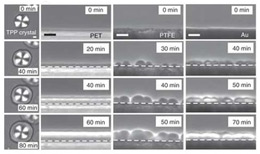Research Abstract
単一成分の分子液体の液体-液体転移における表面ぬれ効果
単一成分の液体であっても、2つ以上の液体状態が存在する可能性がある。このような液体状態間の転移は「液体-液体転移」(LLT)とよばれている。
Surface-wetting effects on the liquid transition of a single-component molecular liquid
2010年5月4日 Nature Communications 1 : 16 doi: 10.1038/ncomms1015

単一成分の液体であっても、2つ以上の液体状態が存在する可能性がある。このような液体状態間の転移は「液体-液体転移」(LLT)とよばれている。 LLTは、主にこのような直感に反する現象の物理的起源についての基礎的な興味から、最近多くの注目を集めてきた。本論文では、分子液体である亜りん酸ト リフェニルにおいてLLTへのぬれ効果を初めて観察したので報告する。LLTのスピノーダル温度に近づくにつれ、核成長型LLTでは部分的ぬれから完全ぬ れへ転移することがわかった。秩序変数の非保存性を反映して、LLTに特有のいくつかの特徴も明らかとなった。さらに、このぬれ挙動は、分散力ではなく、 固体基板への弱い水素結合によって生じることもわかり、LLT自体においても水素結合が重要な役割を演じていることが示唆される。ぬれ効果を用いること で、核成長型LLTの転移ダイナミクスや空間パターンを制御する新たな可能性が開かれるかもしれない。
- 東京大学生産技術研究所
Even a single-component liquid may have more than two liquid states. The transition between them is called a ‘liquid–liquid transition’ (LLT). Such LLTs have recently attracted considerable attention mainly because of the fundamental interest in the physical origin of this counterintuitive phenomenon. In this study, we report the first observation of wetting effects on LLT for a molecular liquid, triphenyl phosphite. We find a transition from partial to complete wetting for nucleation-growth-type LLT when approaching the spinodal temperature of LLT. Some features unique to LLT are also revealed, reflecting for example the non-conserved nature of its order parameter. We also find that the wetting behaviour is not induced by dispersion forces, but by weak hydrogen bonding to a solid substrate, implying its important role in the LLT itself. Using wetting effects may open a new possibility to control kinetics and spatial patterns of nucleation-growth-type LLT.

